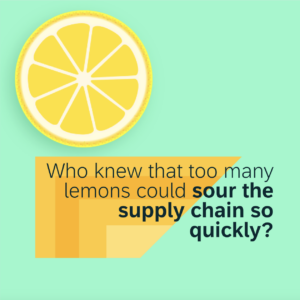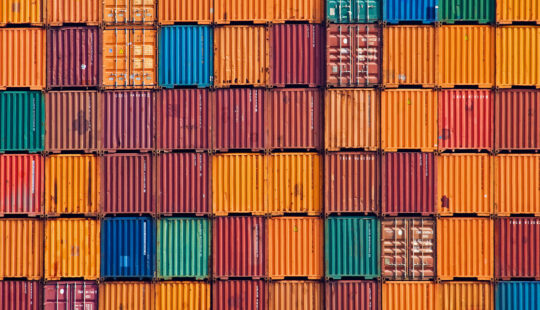 Lemon, whether enjoyed in refreshing summer treats or taken as a daily vitamin, is one of the most popular and widely cultivated fruit crops globally, with 10 million tons produced annually. Since last year, the lemon industry in Spain has been facing significant challenges due to droughts, followed by this year’s surplus.
Lemon, whether enjoyed in refreshing summer treats or taken as a daily vitamin, is one of the most popular and widely cultivated fruit crops globally, with 10 million tons produced annually. Since last year, the lemon industry in Spain has been facing significant challenges due to droughts, followed by this year’s surplus.
Who knew that too many lemons could sour the supply chain so quickly? More lemon doesn’t seem as problematic as a lemon shortage, does it? However, the situation serves as a reminder that an abundance of products can present just as many challenges as a shortage.
The bitter taste of waste
When life gives you lemons or any other produce, it’s usually a good thing – unless you’re a farmer facing a surplus of lemons that nobody wants. Because the overproduction has led to a mismatch with consumer demand. With the surplus in production, farmers are left with an excess of products that are not being sold, which leads to prices dropping faster than a lemon falling off a tree.
According to the Spanish agricultural union COAG, around 400,000 tons – which is about 27% of the planned production- of lemons cannot be sold and will go to waste, and loss is expected to exceed 120 million euros ($129 million).
As lemon prices do not cover production costs, it results in diminished profits and potential financial strain in the main cultivation areas, which even leads farmers to abandon farms and the uprooting of trees.
This has already raised concerns about environmental impact as valuable resources such as water, labor, and land are wasted. Additionally, the situation highlights the need for more sustainable practices in agriculture, such as crop diversification, efficient water usage, and responsible waste management.
The food and beverage industry may find themselves with excess inventory that could go to waste if not used in a timely manner. Similarly, the cosmetic and pharmaceutical sectors incorporate lemons in their products for their positive attributes, potentially impacting their sustainable production and risking harm to their companies’ sustainability objectives or brand reputation in the eyes of consumers.
The bad taste of logistics costs
The surplus in lemon production may kickstart the inventory and transportation challenges. The excessive products take up the valuable warehouse space where more sellable stock could have been stored. This may affect the transportation and storage costs, as distributors are forced to find creative solutions to accommodate the overflow of lemons. This could also lead the lemons to expire and lose their freshness, which increases waste, inflates costs, and decreases the profitability for producers.
Squeezing fresh solutions
To avoid being caught off guard by potential disruptions such as overproduction or waste, supply chains must be well managed and carefully planned, and visibility is crucial in achieving this.
On a recent episode of The Future of Supply Chain podcast, Koray Köse from Everstream emphasized the significance of visibility as the cornerstone of effective supply chain management.
‘‘Everything starts with visibility,” said Köse. “That’s the foundation of knowing and then turning that knowledge into an agile operation that can react quickly to incidents that are comprehensively reported in detail, where you can analyze, specifically, the prioritization of that incident in your value chain.”
Modern supply chain requires modern technologies to help turn risks into opportunities. That is where AI comes into a play to help optimize your risk-resilient and sustainable supply chain.
Richard Howells, VP of Thought Leadership at SAP’s ERP, Finance, and Supply Chain Solutions, stresses the significance of visibility in a recent IDC InfoBrief on the role of AI in Supply Chain and Operations.
“Data visualization and modeling and intelligent summarization came in joint second to help supply chains and operations make sense of data quickly and in a people-intuitive way,” said Howells.
Employing such supply chain planning tools, such as forecasting algorithms and inventory optimization systems, can greatly benefit farmers, wholesalers, and retailers and help in accurately predicting demand and adjusting production accordingly. By utilizing these tools, stakeholders can ensure a more sustainable and risk resilient supply chains for their production processes.
By reducing waste and environmental impact, companies can improve their sustainability efforts and maintain a positive brand reputation. This not only leads to cost savings and improved operational efficiency but also addresses excess inventory in a sustainable and responsible manner.
By acknowledging the necessary tools for the supply chains and implementing the right tools to work together to find innovative solutions that promote efficiency, reduce waste, and support sustainable food system, we can mitigate the negative impacts of overproduction and waste and ensure more resilient and sustainable future for the future generations.
Download the IDC InfoBrief to learn more about the importance of AI in Supply Chain.
This article first appeared in Forbes magazine.



